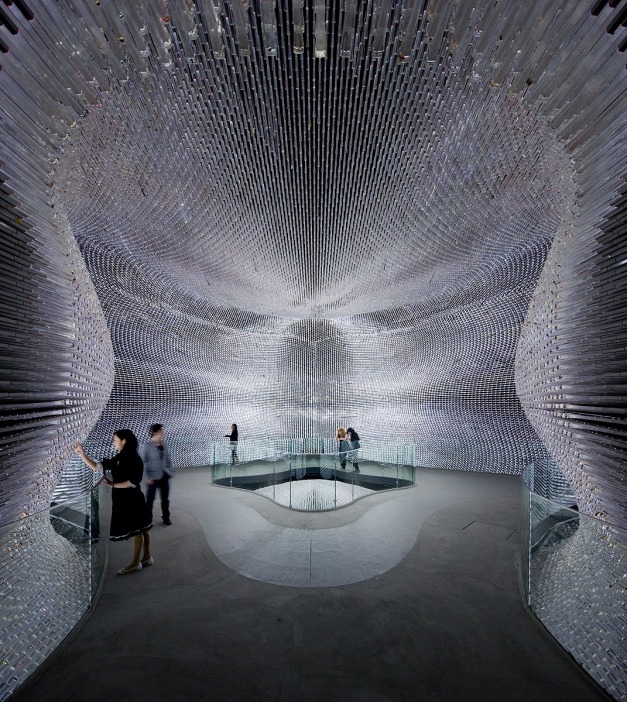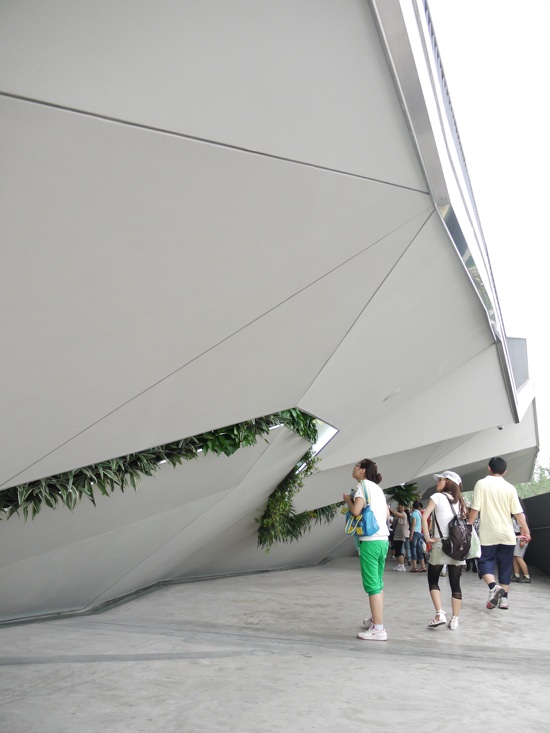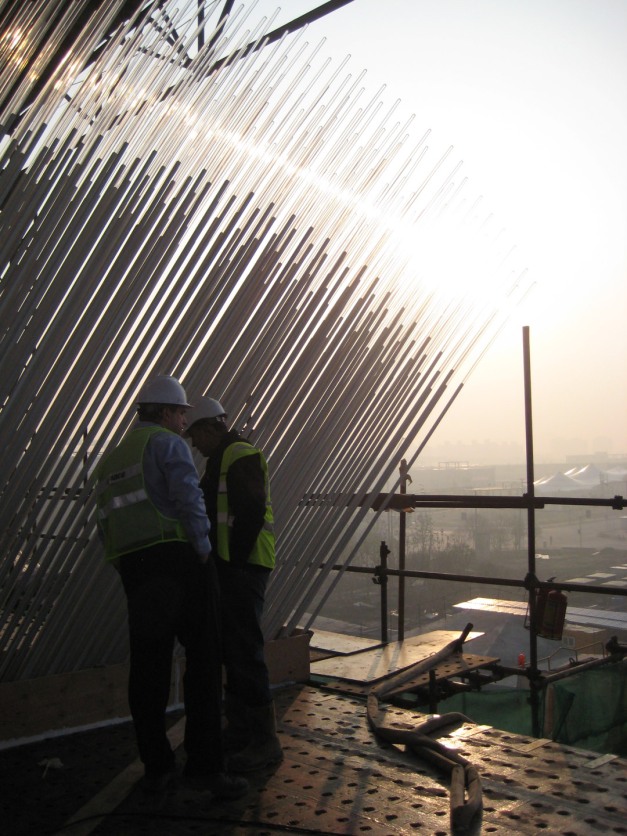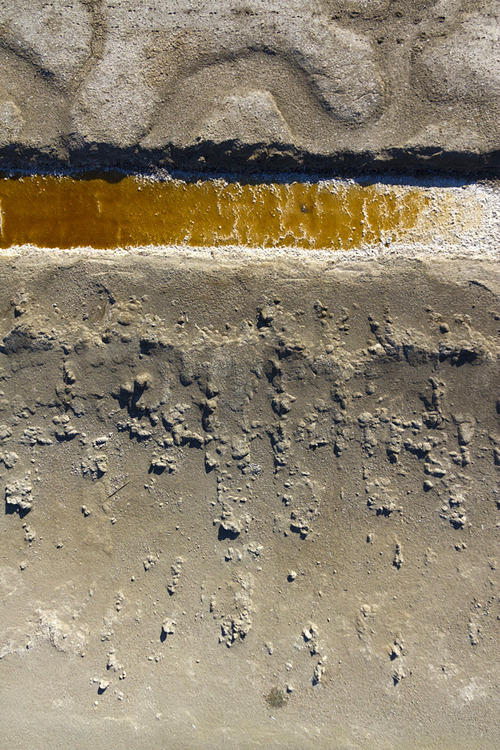From the Studio website: "Following a tradition that began with the Great Exhibition of 1851, World Expo is a vast international fair in which countries participate by creating themed pavilions, representing their nation’s technology, culture and achievements. In 2010, the event was held in Shanghai, China. With more than 200 countries taking part, it was the largest ever Expo.
The competition to design the United Kingdom’s pavilion was won by a team led by Heatherwick Studio. Like the other western countries, the UK’s site was the size of a football pitch but, unlike those countries, the budget given to the project was much smaller. In addition, our brief was that the UK’s pavilion must be one of the expo’s “top five” most popular attractions.
If it was to meet this target, the UK Pavilion would have to stand out from the other 200 pavilions. Instead of trying to shout above the noise, we aimed to do one powerful thing with simplicity and clarity, insisting on surprising visitors by the absence of screens and technological devices. And, because many of the Expo’s seventy million visitors would only see the pavilion from the outside and many more would only experience it on internet or television, we also realised that the outside of the pavilion needed to tell you what was going on inside. The way to achieve this was to make the building be a manifestation of its content.
But we still needed to decide what to say about the UK. Instead of perpetuating outdated stereotypes like London fog, bowler hats and red telephone boxes, we wanted to represent the inventiveness and creativity to be found in contemporary British life. Taking our cue from the Expo theme, which was the future of cities (“better city, better life”), we started to explore the relationships between cities and nature and the significance of plants to human health, economic success and social change.
Developing the masterplan of the site, the restricted budget forced us to be strategic and pragmatic. Because the budget would not go far if we tried to make a building that filled the entire site, we chose to concentrate our resources on creating a memorable focal object, occupying one-fifth of the site, and then devised a quiet, cost-effective architectural treatment to house the functional spaces. Our strategy was to create a public space that filled the site, place our focal object on top of this landscape and tuck the functional facilities underneath it. This space would provide a breathing space, where visitors might recuperate from expo-exhaustion, and frame the focal object by separating it from its chaotic surroundings.
Predicting that many of the Expo’s pavilions might follow architectural trends in form-making, we chose instead to concentrate on exploring texture. We were thinking of the opening sequence of the 1985 film Witness, in which the camera pans across a field of grass swirled into patterns by the wind. On this windy riverside site, we wanted to make the building’s façade behave like this grass. We had once developed a proposal for treating a building like the Play-Doh figure that grows hair when you squeeze coloured paste through the holes in his head, conceiving the tips of these hairs as forming the outward projection of his original shape. It also seemed that if you magnified the texture of a building enough, the texture would actually become its form. We were excited by the idea of making the outside of the building so indefinite that you cannot draw a line between building and sky because they merge into each other. This notion of texture gave us a way to relate to the theme of nature and cities; our pavilion could be a cathedral to seeds, which are immensely significant for the ecology of the planet and fundamental to human nutrition and medicine. For the future-gazing expo, seeds seemed an ultimate symbol of potential and promise.
The Seed Cathedral is a box, 15 metres high and 10 metres tall. From every surface protrude silvery hairs, consisting of 60,000 identical rods of clear acrylic, 7.5 metres long, which extend through the walls of the box and lift it into the air. Inside the pavilion, the geometry of the rods forms a space described by a curvaceous undulating surface. There are 250,000 seeds cast into the glassy tips of all the hairs. By day, the pavilion’s interior is lit by the sunlight that comes in along the length of each rod and lights up the seed ends. You can track the daily movement of the sun and pick out the shadows of passing clouds and birds and, when you move around, the light moves with you, glowing most strongly from the hairs that point directly towards you. By night, light sources inside each rod illuminate not only the seed ends inside the structure, but the tips of the hairs outside it, covering the pavilion in tiny points of light that dance and tingle in the breeze.
The pavilion is sitting on a landscape that is crumpled and folded like a sheet of paper, which suggests that the pavilion is a gift from the UK to China, still partly enclosed in wrapping paper. With inclined surfaces and lifted edges forming a gentle amphitheatre, the landscape is entirely carpeted in silvery-grey Astroturf, which translates the softness of the Seed Cathedral into a more tactile softness underfoot and invites you to sit anywhere, lie down or even play, rolling down the slopes. Its atmosphere of intimacy and ambiguity of purpose allows people to treat the space like a village green, invoking the UK’s record as a pioneer of the modern public park.
Also incorporated within the landscape’s sloping surfaces are the ramps into the pavilion, along which are a series of artistic installations, designed by Troika, exploring the theme of nature and cities. Underneath the landscape 1500 square metres of required accommodation that includes a VIP suite, hospitality facilities and offices can be found.
Working with structural engineer Adams Kara Taylor, we spent many weeks setting out the geometry of the pavilion’s hairs. We designed a specific quirk into the outside, which meant that, from every angle, the image of the Union Jack appeared within the hairs of the pavilion.
In the duration of the six-month Expo, more than eight million people went inside the Seed Cathedral, making it the UK’s most visited tourist attraction. At a state ceremony, it was announced that the UK Pavilion had won the event’s top prize, the gold medal for pavilion design."





























